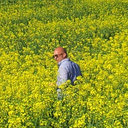Ethnobotanical investigation on wild medicinal plants in the Monti Sicani Regional Park (Sicily, Italy).
Sleutelwoorden
Abstract
BACKGROUND
The area of the "Monte Sicani Regional Park" (Central Western Sicily, southern Italy) has been quantitatively and extensively investigated in an ethnobotanical study for the first time. A total of 108 wild species are used for medicinal purposes, while, according to our study, the uses of 9 species have not previously been reported in ethnobotanical studies in Italy (e.g., the use of Kickxia elatine (L.) Dumort. for the treatment of hyperhydrosis of the feet, the use of Lavatera agrigentina Tineo for cough and bronchitis).
OBJECTIVE
The aim of this paper is to analyze, through quantitative indicators, the extent of the current knowledge on medicinal uses of plants in the area, evaluating also the features of uniqueness and commonality of this knowledge in comparison with other Italian and Mediterranean areas.
METHODS
Semi-structured interviews were carried out in the local communities between 2009 and 2010 within the Monti Sicani Regional Park with local people retained experts in rural traditions. A total of 230 people were interviewed about their knowledge on medicinal plant uses. Local plant uses were evaluated using ethnobotanical indices (e.g., cultural importance index, ethnobotanicity index, informant consensus factor) and then compared with uses in other localities in Sicily, Italy and the Mediterranean basin.
RESULTS
Local communities currently use a total number of 108 wild species (43 families) as remedies for human and livestock ailments. The majority of plants are used in the treatment of articular, skin and gastrointestinal problems. The use of some species is limited to Sicily (e.g., Rhus coriaria L., Athamanta sicula L., Senecio delphinifolius Vahl).
CONCLUSIONS
The research shows an ongoing process of cultural erosion in an advanced stage, but results still highlight an interesting cultural identity as regards the local folk medicine.





